Republic of Ireland: Difference between revisions
Created page with 'The '''Republic of Ireland''' is named simply '''Ireland''' in its constitution. It is an independent republic whose territory covers the greater part of the island of [[Ireland…' |
|||
| (7 intermediate revisions by 4 users not shown) | |||
| Line 1: | Line 1: | ||
[[File:Europe location IRL.png|right|thumb|300px|The location of the Republic of Ireland]] | |||
[[File:Flag of Ireland.svg|right|thumb|200px|The Irish Flag]] | |||
The '''Republic of Ireland''' is named simply '''Ireland''' in its constitution. It is an independent republic whose territory covers the greater part of the island of [[Ireland]] and consists of that part of Ireland which was separated from the [[United Kingdom]] in 1922 to form the Irish Free State. | The '''Republic of Ireland''' is named simply '''Ireland''' in its constitution. It is an independent republic whose territory covers the greater part of the island of [[Ireland]] and consists of that part of Ireland which was separated from the [[United Kingdom]] in 1922 to form the Irish Free State. | ||
| Line 17: | Line 19: | ||
[[File:Cliffs of Moher, Clare.jpg|right|thumb|200px|The Cliffs of Moher on the Atlantic coast]] | [[File:Cliffs of Moher, Clare.jpg|right|thumb|200px|The Cliffs of Moher on the Atlantic coast]] | ||
[[File:Deciduous woodland by the Owengarriff River - geograph.org.uk - 449903.jpg|right|thumb|200px|Deciduous woodland in County Kerry]] | [[File:Deciduous woodland by the Owengarriff River - geograph.org.uk - 449903.jpg|right|thumb|200px|Deciduous woodland in County Kerry]] | ||
[[File:Glendalough.jpg|right|thumb|200px|Glendalough valley in County Wicklow]] | |||
Ireland extends over an area of approximately five-sixths of the island of [[Ireland]], with [[Northern Ireland]] constituting the remainder. The island is bounded to the north and west by the [[Atlantic Ocean]] and to the northeast by the [[North Channel]]. To the east, the [[Irish Sea]] connects to the Atlantic Ocean by way of [[St George's Channel]]. | Ireland extends over an area of approximately five-sixths of the island of [[Ireland]], with [[Northern Ireland]] constituting the remainder. The island is bounded to the north and west by the [[Atlantic Ocean]] and to the northeast by the [[North Channel]]. To the east, the [[Irish Sea]] connects to the Atlantic Ocean by way of [[St George's Channel]]. | ||
| Line 25: | Line 28: | ||
Before the arrival of the first settlers in Ireland approximately 9,000 years ago, the landscape was extensively covered by forests of oak, ash, elm, hazel, yew, and other native trees.<ref>{{cite web |url=http://www.forestryservices.ie/history|title=History of Forestry in Ireland|accessdate=15 June 2011}}</ref> The growth of blanket bog and the extensive clearing of woodland to facilitate farming are believed to be the main causes of deforestation during the subsequent centuries. Today, approximately 12% of Ireland is forested, of which a significant majority is composed of mainly non-native coniferous plantations for commercial use.<ref>{{cite web|url=http://epp.eurostat.ec.europa.eu/cache/ITY_PUBLIC/5-15062011-BP/EN/5-15062011-BP-EN.PDF|title=Forests cover around 40% of the EU27 land area|accessdate=20 June 2011}}</ref> Ideal soil conditions, high rainfall and a mild climate give Ireland the highest growth rates for forests in Europe. Hedgerows, which are traditionally used to define land boundaries, are an important substitute for woodland habitat, providing refuge for native wild flora and a wide range of insect, bird and mammal species.<ref>{{cite web|url=http://www.noticenature.ie/Hedgerow.html|title=Hedgerows|accessdate=15 June 2011}}</ref> | Before the arrival of the first settlers in Ireland approximately 9,000 years ago, the landscape was extensively covered by forests of oak, ash, elm, hazel, yew, and other native trees.<ref>{{cite web |url=http://www.forestryservices.ie/history|title=History of Forestry in Ireland|accessdate=15 June 2011}}</ref> The growth of blanket bog and the extensive clearing of woodland to facilitate farming are believed to be the main causes of deforestation during the subsequent centuries. Today, approximately 12% of Ireland is forested, of which a significant majority is composed of mainly non-native coniferous plantations for commercial use.<ref>{{cite web|url=http://epp.eurostat.ec.europa.eu/cache/ITY_PUBLIC/5-15062011-BP/EN/5-15062011-BP-EN.PDF|title=Forests cover around 40% of the EU27 land area|accessdate=20 June 2011}}</ref> Ideal soil conditions, high rainfall and a mild climate give Ireland the highest growth rates for forests in Europe. Hedgerows, which are traditionally used to define land boundaries, are an important substitute for woodland habitat, providing refuge for native wild flora and a wide range of insect, bird and mammal species.<ref>{{cite web|url=http://www.noticenature.ie/Hedgerow.html|title=Hedgerows|accessdate=15 June 2011}}</ref> | ||
Agriculture accounts for approximately 64% of the total land area.<ref>{{cite web|url=http://www.teagasc.ie/agrifood |title=Agriculture in Ireland |publisher=Teagasc.ie |date= |accessdate=12 November 2010}}</ref> This has resulted in limited land to preserve natural habitats, in particular for larger wild mammals with greater territorial requirements.<ref name="land_cover">{{cite web | Agriculture accounts for approximately 64% of the total land area.<ref>{{cite web|url=http://www.teagasc.ie/agrifood |title=Agriculture in Ireland |publisher=Teagasc.ie |date= |accessdate=12 November 2010}}</ref> This has resulted in limited land to preserve natural habitats, in particular for larger wild mammals with greater territorial requirements.<ref name="land_cover">{{cite web | ||
|title = Land cover and land use | |title = Land cover and land use | ||
| Line 32: | Line 34: | ||
|url=http://www.epa.ie/whatwedo/assessment/land/ | |url=http://www.epa.ie/whatwedo/assessment/land/ | ||
|accessdate = 30 July 2007}}</ref> The long history of agricultural production coupled with modern agricultural methods, such as pesticide and fertiliser use, has placed pressure on biodiversity. | |accessdate = 30 July 2007}}</ref> The long history of agricultural production coupled with modern agricultural methods, such as pesticide and fertiliser use, has placed pressure on biodiversity. | ||
{{clear}} | |||
==Counties and Provinces== | ==Counties and Provinces== | ||
[[File:Coat of arms of Ireland.svg|right|thumb|150px|The Arms of Ireland]] | |||
{{Main|Counties of the Republic of Ireland}} | {{Main|Counties of the Republic of Ireland}} | ||
{{Main|Provinces of Ireland}} | {{Main|Provinces of Ireland}} | ||
{| | The Republic of Ireland has twenty-six counties, conventionally divided between the [[Provinces of Ireland]]: | ||
| | {| style="width: 70%" | ||
|-valign="top" | |||
| | |||
:''[[Connaught]]'' | :''[[Connaught]]'' | ||
#[[County Galway|Galway]] | #[[County Galway|Galway]] | ||
| Line 44: | Line 49: | ||
#[[County Roscommon|Roscommon]] | #[[County Roscommon|Roscommon]] | ||
#[[County Sligo|Sligo]] | #[[County Sligo|Sligo]] | ||
| | |||
:''[[Leinster]]'' | :''[[Leinster]]'' | ||
#[[County Carlow|Carlow]] | #[[County Carlow|Carlow]] | ||
| Line 58: | Line 63: | ||
#[[County Wexford|Wexford]] | #[[County Wexford|Wexford]] | ||
#[[County Wicklow|Wicklow]] | #[[County Wicklow|Wicklow]] | ||
| | |||
:''[[Munster]]'' | :''[[Munster]]'' | ||
#[[County Clare|Clare]] | #[[County Clare|Clare]] | ||
| Line 66: | Line 71: | ||
#[[County Tipperary|Tipperary]] | #[[County Tipperary|Tipperary]] | ||
#[[County Waterford|Waterford]] | #[[County Waterford|Waterford]] | ||
| | |||
:''[[Ulster]]'' | :''[[Ulster]]'' | ||
#[[County Cavan|Cavan]] | #[[County Cavan|Cavan]] | ||
| Line 83: | Line 88: | ||
Other languages spoken in the Republic of Ireland include Shelta, spoken by Irish Travellers, and Ulster Scots , a dialect of Scots spoken in [[County Donegal|Donegal]].<ref>[http://www.ulsterscotsagency.com/what-is-ulster-scots/language/ An introduction to the Ulster-Scots Language], Ulster-Scots Agency.</ref> Most secondary school students choose to learn one or two foreign languages. | Other languages spoken in the Republic of Ireland include Shelta, spoken by Irish Travellers, and Ulster Scots , a dialect of Scots spoken in [[County Donegal|Donegal]].<ref>[http://www.ulsterscotsagency.com/what-is-ulster-scots/language/ An introduction to the Ulster-Scots Language], Ulster-Scots Agency.</ref> Most secondary school students choose to learn one or two foreign languages. | ||
==Religion== | ==Religion== | ||
Religious freedom is constitutionally provided for in Ireland. The [[Roman Catholic Church]] is the largest church. In 2006, 86.8% of the population identified themselves as Roman Catholic, 4.8% as Protestant or another Christian religion, 2% as non-Christian, and 1.6% did not state their religion. Before the Civil War, the Protestant population was far higher, though always a minority, and Protestants dominated in many fields. | Religious freedom is constitutionally provided for in Ireland. The [[Roman Catholic Church]] is the largest church. In 2006, 86.8% of the population identified themselves as Roman Catholic, 4.8% as Protestant or another Christian religion, 2% as non-Christian, and 1.6% did not state their religion. Before the Civil War, the Protestant population was far higher, though always a minority, and Protestants dominated in many fields. | ||
| Line 92: | Line 97: | ||
The [[Church of Ireland]] is the second largest Christian denomination. Membership declined throughout the twentieth century, but has recently experienced an increase, as have other small Christian denominations. | The [[Church of Ireland]] is the second largest Christian denomination. Membership declined throughout the twentieth century, but has recently experienced an increase, as have other small Christian denominations. | ||
Significant Protestant denominations are the Presbyterian Church | Significant Protestant denominations are the Presbyterian Church and Methodist Church. | ||
Immigration has contributed to a growth in Hindu and Muslim populations. | Immigration has contributed to a growth in Hindu and Muslim populations. | ||
| Line 105: | Line 110: | ||
The union with Great Britain had not been popular with all the population, in particular those who had nurtured ambitions for Ireland in the preceding century, and there grew up a "Repeal" movement, seeking the repeal of the union. The movement was not always peaceful, and indeed it was reported that during the famine many in Great Britain were deterred from contributing to the many relief funds established before of stories that Irishmen were spending the money on weapons for rebellion. | The union with Great Britain had not been popular with all the population, in particular those who had nurtured ambitions for Ireland in the preceding century, and there grew up a "Repeal" movement, seeking the repeal of the union. The movement was not always peaceful, and indeed it was reported that during the famine many in Great Britain were deterred from contributing to the many relief funds established before of stories that Irishmen were spending the money on weapons for rebellion. | ||
From 1874, particularly under Charles Stewart Parnell from 1880, the Irish Parliamentary Party moved to prominence through widespread agrarian agitation, through the Irish Land League, that won improved tenant land reforms in the form of the Irish Land Acts. It also attempted to achieve Home Rule, an effort led by the Liberal Party under William Ewart Gladstone. During Gladstone's long tenure as Prime Minister he brought two Home Rule Bills to Parliament which would have granted Ireland autonomy within the United Kingdom. The Home Rule debate caused a repolarisation of the Victorian political debate and divided the Liberal Party - the Liberal Unionists left to create their own party, which eventually joined the Conservatives - and in the event the Home Rule Bills were rejected by the House of Lords. This failure disenchanting and radicalised the Irish Roman Catholic middle classes who had expected to take power into their own hands as a new political class. Nevertheless, "grass-roots" control of local affairs was achieved under the Local Government (Ireland) Act 1898, by which elected county councils were created for the | From 1874, particularly under Charles Stewart Parnell from 1880, the Irish Parliamentary Party moved to prominence through widespread agrarian agitation, through the Irish Land League, that won improved tenant land reforms in the form of the Irish Land Acts. It also attempted to achieve Home Rule, an effort led by the Liberal Party under William Ewart Gladstone. During Gladstone's long tenure as Prime Minister he brought two Home Rule Bills to Parliament which would have granted Ireland autonomy within the United Kingdom. The Home Rule debate caused a repolarisation of the Victorian political debate and divided the Liberal Party - the Liberal Unionists left to create their own party, which eventually joined the Conservatives - and in the event the Home Rule Bills were rejected by the House of Lords. This failure disenchanting and radicalised the Irish Roman Catholic middle classes who had expected to take power into their own hands as a new political class. Nevertheless, "grass-roots" control of local affairs was achieved under the Local Government (Ireland) Act 1898, by which elected county councils were created for the first time, removing local power from grand juries consisting largely of the landowners constituting the Protestant Ascendancy. | ||
[[File:Irish UK general election Dec 1910.png|right|thumb|180px|General election results in Ireland, 1910]] | [[File:Irish UK general election Dec 1910.png|right|thumb|180px|General election results in Ireland, 1910]] | ||
| Line 122: | Line 127: | ||
[[File:Dáil Chamber.jpg|thumb|right|thumb|200px|The Chamber of the Dáil Éireann]] | [[File:Dáil Chamber.jpg|thumb|right|thumb|200px|The Chamber of the Dáil Éireann]] | ||
The Irish War of Independence broke out soon afterwards. A truce was called in July 1921, and representatives of the British government | The Irish War of Independence broke out soon afterwards. A truce was called in July 1921, and representatives of the British government and the Irish treaty delegates negotiated the Anglo-Irish Treaty in London from 11 October to 6 December 1921. The Second Dáil Éireann narrowly ratified the Treaty. | ||
===The Irish Free State and civil war=== | ===The Irish Free State and civil war=== | ||
| Line 134: | Line 139: | ||
De Valera was defeated in battle but later he became Prime Minister, and introduced a new Constitution. On 29 December 1937, the new "Constitution of Ireland"; it called the state ''Ireland'', or ''Éire'' in Irish, removed reference to the King in the Constitution and established the office of President. The Governor-General's office was soon abolished too. Although the Constitution established the office of President of Ireland, the question over whether Ireland was a republic remained open. Diplomats were accredited to the King, but the President exercised the internal functions of a Head of State. | De Valera was defeated in battle but later he became Prime Minister, and introduced a new Constitution. On 29 December 1937, the new "Constitution of Ireland"; it called the state ''Ireland'', or ''Éire'' in Irish, removed reference to the King in the Constitution and established the office of President. The Governor-General's office was soon abolished too. Although the Constitution established the office of President of Ireland, the question over whether Ireland was a republic remained open. Diplomats were accredited to the King, but the President exercised the internal functions of a Head of State. | ||
Ireland remained neutral | Ireland remained neutral during World War II, a period it described as "The Emergency", though many Irishmen joined the British Army during the War; more indeed came from the Free State than from Northern Ireland. | ||
De Valera secured the end of the State's link with the monarchy with the Republic of Ireland Act 1948, which came into force on 18 April 1949 and declared that the state was a republic. At the time, a declaration of a republic terminated Commonwealth membership, which was dependent on common allegiance to the Crown, and the Republic of Ireland left the Commonwealth (this rule was changed 10 days later to accommodate India's desire for a republican constitution but Ireland did not reapply). | De Valera secured the end of the State's link with the monarchy with the Republic of Ireland Act 1948, which came into force on 18 April 1949 and declared that the state was a republic. At the time, a declaration of a republic terminated Commonwealth membership, which was dependent on common allegiance to the Crown, and the Republic of Ireland left the Commonwealth (this rule was changed 10 days later to accommodate India's desire for a republican constitution but Ireland did not reapply). | ||
| Line 215: | Line 220: | ||
{{Catself}} | {{Catself}} | ||
[[Category:Ireland]] | [[Category:Ireland]] | ||
[[Category:British Isles]] | |||
Latest revision as of 12:21, 7 May 2014

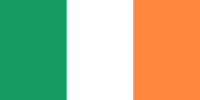
The Republic of Ireland is named simply Ireland in its constitution. It is an independent republic whose territory covers the greater part of the island of Ireland and consists of that part of Ireland which was separated from the United Kingdom in 1922 to form the Irish Free State.
The modern Irish state gained independence from the United Kingdom in 1922 after a bloody rebellion and civil conflict was ended by the Anglo-Irish Treaty. The new state was initially a dominion within the British Empire called the Irish Free State, but a new constitution was adopted in 1937 and with it the name "Ireland". In 1949 the remaining duties of the King were removed and Ireland was declared a republic, with the description Republic of Ireland. In consequence, the state left the Commonwealth.
The Republic has the 26 counties which together cover some five-sixths of Ireland. The rest of the island, namely the six counties of Northern Ireland are part of the United Kingdom.
The capital of the Republic of Ireland is the City of Dublin in County Dublin on the east coast. The state has only one land border, namely that with the United Kingdom. It is otherwise surrounded by the Atlantic Ocean to the west and south, St George's Channel to the southeast, and the Irish Sea to the east.
Name
The Constitution of Ireland provides that "The name of the State is Éire, or, in the English language, Ireland". Under Irish statute law, "Republic of Ireland" (or Poblacht na hÉireann in Irish) is "the description of the State".[1] This official description was provided for in the Republic of Ireland Act 1948, which transferred the remaining duties of the King to the Uachtaráin.
The name Ireland for the Irish state has been a source of dispute between the United Kingdom and the Republic because it implies a claim to all of Ireland, of which part is within the United Kingdom. Within the 1998 Good Friday Agreement, the two sides sought to resolve such issues and in accordance with that agreement the Republic of Ireland dropped its constitutional claim to jurisdiction over the entire island of Ireland and the United Kingdom does not object to the use of the name "Ireland".
Along with general use of the official name Ireland, the Republic of Ireland description is frequently used for the state.
Geography
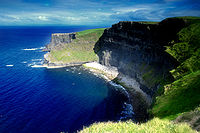
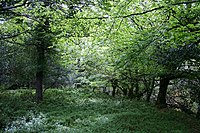

Ireland extends over an area of approximately five-sixths of the island of Ireland, with Northern Ireland constituting the remainder. The island is bounded to the north and west by the Atlantic Ocean and to the northeast by the North Channel. To the east, the Irish Sea connects to the Atlantic Ocean by way of St George's Channel.
The western landscape mostly consists of rugged cliffs, hills and mountains. The central lowlands are extensively covered with glacial deposits of clay and sand, as well as significant areas of bogland and several lakes. The highest point is Carrauntoohil, 3,406 feet, in Macgillycuddy's Reeks, a mountain range in County Kerry. The River Shannon, which traverses the central lowlands, is the longest river in Ireland at 241 miles from Shannon Pot to the sea.
The west coast, storm-battered by the Atlantic Ocean, is more rugged than the east, with numerous islands, peninsulas, headlands and bays.
Before the arrival of the first settlers in Ireland approximately 9,000 years ago, the landscape was extensively covered by forests of oak, ash, elm, hazel, yew, and other native trees.[2] The growth of blanket bog and the extensive clearing of woodland to facilitate farming are believed to be the main causes of deforestation during the subsequent centuries. Today, approximately 12% of Ireland is forested, of which a significant majority is composed of mainly non-native coniferous plantations for commercial use.[3] Ideal soil conditions, high rainfall and a mild climate give Ireland the highest growth rates for forests in Europe. Hedgerows, which are traditionally used to define land boundaries, are an important substitute for woodland habitat, providing refuge for native wild flora and a wide range of insect, bird and mammal species.[4]
Agriculture accounts for approximately 64% of the total land area.[5] This has resulted in limited land to preserve natural habitats, in particular for larger wild mammals with greater territorial requirements.[6] The long history of agricultural production coupled with modern agricultural methods, such as pesticide and fertiliser use, has placed pressure on biodiversity.
Counties and Provinces
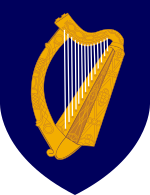
- Main article: Counties of the Republic of Ireland
- Main article: Provinces of Ireland
The Republic of Ireland has twenty-six counties, conventionally divided between the Provinces of Ireland:
Language
Irish is declared the "national language" by the Constitution, but few speak it. English is the dominant language. In the 2006 census, 39% of the population regarded themselves as competent in Irish. Irish is spoken as a community language only in a small number of rural areas mostly in the west of the country, collectively known as the Gaeltacht.
Outside the Gaeltacht regions, road signs are usually bilingual. Most public notices and print media are in English only. Most Government publications are available in both languages, and citizens have the right to deal with the state in Irish.
Media in Irish exist on television (TG4), radio (for example RTÉ Raidió na Gaeltachta) and print (for example Foinse). In the Irish Defence Forces, all foot and arms drill commands are given in the Irish language.
As a result of immigration, Polish is one of the most widely spoken languages in Ireland after English and Irish.
Other languages spoken in the Republic of Ireland include Shelta, spoken by Irish Travellers, and Ulster Scots , a dialect of Scots spoken in Donegal.[7] Most secondary school students choose to learn one or two foreign languages.
Religion
Religious freedom is constitutionally provided for in Ireland. The Roman Catholic Church is the largest church. In 2006, 86.8% of the population identified themselves as Roman Catholic, 4.8% as Protestant or another Christian religion, 2% as non-Christian, and 1.6% did not state their religion. Before the Civil War, the Protestant population was far higher, though always a minority, and Protestants dominated in many fields.
According to a Georgetown University study, the country has one of the highest rates of regular attendance at Roman Catholic Mass in the Western World. While daily attendance was 13% in 2006, there was a reduction in weekly attendance from 81% in 1990 to 48% in 2006, although the decline was reported as stabilising.[8] In 2011, it was reported that weekly Mass attendance in Dublin was just 18%, with it being even lower among younger generations.[9]
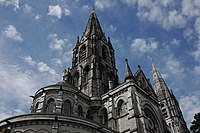
The Church of Ireland is the second largest Christian denomination. Membership declined throughout the twentieth century, but has recently experienced an increase, as have other small Christian denominations.
Significant Protestant denominations are the Presbyterian Church and Methodist Church.
Immigration has contributed to a growth in Hindu and Muslim populations.
History
From the Union
The Act of Union of 1800 took effect on, 1 January 1801,uniting the two kingdoms of Great Britain and Ireland into one kingdom to be known as The United Kingdom of Great Britain and Ireland, and form that date until 6 December 1922, all the island of Ireland was part of the United Kingdom.
During the Irish Potato Famine, from 1845 to 1849, the island's population of over 8 million fell by 30%. One million Irishmen died of starvation or disease and another 1.5 million emigrated, particularly to the United States.[10] This mass emigration set the pattern of emigration for the century to come, resulting in a constant population decline up to the 1960s.
Home-rule movement
The union with Great Britain had not been popular with all the population, in particular those who had nurtured ambitions for Ireland in the preceding century, and there grew up a "Repeal" movement, seeking the repeal of the union. The movement was not always peaceful, and indeed it was reported that during the famine many in Great Britain were deterred from contributing to the many relief funds established before of stories that Irishmen were spending the money on weapons for rebellion.
From 1874, particularly under Charles Stewart Parnell from 1880, the Irish Parliamentary Party moved to prominence through widespread agrarian agitation, through the Irish Land League, that won improved tenant land reforms in the form of the Irish Land Acts. It also attempted to achieve Home Rule, an effort led by the Liberal Party under William Ewart Gladstone. During Gladstone's long tenure as Prime Minister he brought two Home Rule Bills to Parliament which would have granted Ireland autonomy within the United Kingdom. The Home Rule debate caused a repolarisation of the Victorian political debate and divided the Liberal Party - the Liberal Unionists left to create their own party, which eventually joined the Conservatives - and in the event the Home Rule Bills were rejected by the House of Lords. This failure disenchanting and radicalised the Irish Roman Catholic middle classes who had expected to take power into their own hands as a new political class. Nevertheless, "grass-roots" control of local affairs was achieved under the Local Government (Ireland) Act 1898, by which elected county councils were created for the first time, removing local power from grand juries consisting largely of the landowners constituting the Protestant Ascendancy.
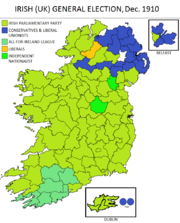
In 1911 the Parliament Act abolished the veto of the House of Lords, and John Redmond secured the passage of the Third Home Rule Bill, as the Government of Ireland Act 1914.
The Unionist movement had been growing since 1886 among Irish Protestants after the introduction of the first home rule bill, fearing discrimination and loss of economic and social privileges if Irish Roman Catholics achieved real political power; "Home Rule is Rome Rule" was the slogan. In the late nineteenth and early twentieth century unionism was particularly strong in Ulster, where industrialisation was more common in contrast to the more agrarian rest of the island. It was feared that any tariff barriers would heavily affect that region. In addition, the Protestant population was more prominent in Ulster, with a majority in four counties. Under the leadership of the Dublin-born Sir Edward Carson of the Irish Unionist Party and the Sir James Craig of the Ulster Unionist Party, unionists became strongly militant in order to oppose the Coercion of Ulster. After the Government of Ireland Act 1914 was passed the Prime Minister, Herbert Asquith, secured an amending Act to avoid rebellion in Ulster, which provided for the exclusion of Ulster from the workings of the bill for a trial period of six years, with an as yet undecided new set of measures to be introduced for the area to be excluded.
Home Rule and rebellion
The implementation of the Home Rule Act 1914 was suspended after the World War broke out in September that year. For the prior reasons of ensuring the implementation of the Act at the end of the war, Redmond and his Irish National Volunteers supported the Allied cause, and 175,000 joined Irish regiments of the 10th (Irish), 16th (Irish), while Unionists joined the 36th (Ulster) divisions of the New British Army.[11]
Some of the more militant nationalists were not content to await the end of the war with Germany. On Easter Day, 1916 a group of the Irish Republican Army seized the General Post Office in Dublin and proclaimed the "Irish Republic". This "Easter Rising" was swiftly defeated and the leaders were executed for treason. A shipment of weapons sent by Germany was seized at sea.
In January 1919, after the December 1918 general election, 73 of Ireland's 106 MPs elected were Sinn Féin members and they refused to take their seats in the British House of Commons. Instead, they met apart as an Irish parliament they called the Dáil Éireann. This Dáil in January 1919 issued a Declaration of Independence and proclaimed an Irish Republic. The Declaration was mainly a restatement of the 1916 Proclamation with the additional provision that Ireland was no longer a part of the United Kingdom. The new Irish Republic was recognised internationally only by the Russian Soviet Republic. The nominal Republic's Aireacht (ministry) sent a delegation under Seán T. O'Kelly to the Paris Peace Conference of 1919, but it was not admitted.
The Government of Ireland Act 1914 was repealed and replaced by the Government of Ireland Act 1920 providing for two autonomous entities; Southern Ireland and Northern Ireland. The institutions of Southern Ireland never became effective however (of its elected Parliament, only two members turned up) and the self-declared Dáil continued to meet.
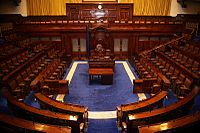
The Irish War of Independence broke out soon afterwards. A truce was called in July 1921, and representatives of the British government and the Irish treaty delegates negotiated the Anglo-Irish Treaty in London from 11 October to 6 December 1921. The Second Dáil Éireann narrowly ratified the Treaty.
The Irish Free State and civil war
In accordance with the Treaty, on 6 December 1922 a self-governing British dominion was to be created, called the Irish Free State, and the Parliament of Northern Ireland had the option to leave the state, which it did forthwith by making an Address to the King requesting, "that the powers of the Parliament and Government of the Irish Free State shall no longer extend to Northern Ireland."[12]
The Irish Free State was duly established as a constitutional monarchy with a Governor-General, a bicameral parliament, a cabinet called the "Executive Council" and a prime minister.
Anti-Treaty led by Éamon de Valera, objected to the acceptance of the Treaty and its abolition of the Irish Republic of 1919 to which they had sworn loyalty, and civil war broke out between Anti-Treaty and Pro-Treaty forces. The pro-treaty forces were able to build up an Irish Army with many tens of thousands of World War I veterans from the 1922 disbanded Irish regiments of the British Army, capable of overwhelming the anti-Treatyists. British supplies of artillery, aircraft, machine-guns and ammunition boosted pro-treaty forces, and the threat of a return of Crown forces to the Free State removed any doubts about the necessity of enforcing the treaty. The lack of public support for the anti-treaty forces (often called the Irregulars) and the determination of the government to overcome the Irregulars contributed significantly to their defeat.
1937 Constitution
De Valera was defeated in battle but later he became Prime Minister, and introduced a new Constitution. On 29 December 1937, the new "Constitution of Ireland"; it called the state Ireland, or Éire in Irish, removed reference to the King in the Constitution and established the office of President. The Governor-General's office was soon abolished too. Although the Constitution established the office of President of Ireland, the question over whether Ireland was a republic remained open. Diplomats were accredited to the King, but the President exercised the internal functions of a Head of State.
Ireland remained neutral during World War II, a period it described as "The Emergency", though many Irishmen joined the British Army during the War; more indeed came from the Free State than from Northern Ireland.
De Valera secured the end of the State's link with the monarchy with the Republic of Ireland Act 1948, which came into force on 18 April 1949 and declared that the state was a republic. At the time, a declaration of a republic terminated Commonwealth membership, which was dependent on common allegiance to the Crown, and the Republic of Ireland left the Commonwealth (this rule was changed 10 days later to accommodate India's desire for a republican constitution but Ireland did not reapply).
Recent history
Ireland became a member of the United Nations in December 1955, after previously being denied membership due to its neutral stance during the War.[13] It joined the European Free Trade Area when the United Kingdom created it, and joined the European Economic Community alongside Britain in 1973.
The economic crisis of the late 1970s was fueled by Fianna Fáil's budget, the abolition of the car tax, excessive borrowing, and global economic instability. There were significant policy changes from 1989 onwards, with economic reform, tax cuts, welfare reform, an increase in competition, and a ban on borrowing to fund current spending. This policy began in 1989–1992 by the Fianna Fáil/Progressive Democrat government, and continued by the subsequent Fianna Fáil/Labour government and Fine Gael/Labour/Democratic Left government. Funded by borrowing and European Regional Assistance Funding, the Republic became one of the world's fastest growing economies by the late 1990s in what was known as the Celtic Tiger period, which lasted until the global financial crisis of 2007–2010.
In the Northern Ireland question, Irish governments started to seek a peaceful reunification of Ireland and have usually cooperated with the British government in the violent conflict involving many paramilitaries and the British Army in Northern Ireland known as "The Troubles". A peace settlement for Northern Ireland, the Belfast Agreement, was approved in 1998 in referendums north and south of the border. As part of the peace settlement, Ireland dropped the territorial claim to Northern Ireland from its constitution.
Government
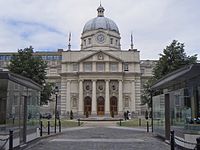
The Republic of Ireland is a constitutional republic governed as a parliamentary democracy on the Westminster model. It has an elected President or Uachtaráin serving as head of state, while the head of government is the Taoiseach.
The parliament, the Oireachtas, consists of two houses, the Seanad and the Dáil Éireann. The houses of the Oireachtas meet at Leinster House in Dublin.
The President serves as head of state, and is elected for a seven-year term and may be re-elected once. The President is primarily a figurehead, but is entrusted with certain constitutional powers with the advice of the Council of State. The office has absolute discretion in some areas, such as referring a bill to the Supreme Court for a judgment on its constitutionality.[14]
References
- ↑ Government of Ireland (1948). "Article 2". Republic of Ireland Act, 1948. Dublin: Government of Ireland. http://www.irishstatutebook.ie/1948/en/act/pub/0022/sec0002.html#zza22y1948s2. "It is hereby declared that the description of the State shall be the Republic of Ireland."
- ↑ "History of Forestry in Ireland". http://www.forestryservices.ie/history. Retrieved 15 June 2011.
- ↑ "Forests cover around 40% of the EU27 land area". http://epp.eurostat.ec.europa.eu/cache/ITY_PUBLIC/5-15062011-BP/EN/5-15062011-BP-EN.PDF. Retrieved 20 June 2011.
- ↑ "Hedgerows". http://www.noticenature.ie/Hedgerow.html. Retrieved 15 June 2011.
- ↑ "Agriculture in Ireland". Teagasc.ie. http://www.teagasc.ie/agrifood. Retrieved 12 November 2010.
- ↑ "Land cover and land use". Environmental Protection Agency. 2000. http://www.epa.ie/whatwedo/assessment/land/. Retrieved 30 July 2007.
- ↑ An introduction to the Ulster-Scots Language, Ulster-Scots Agency.
- ↑ Irish Mass attendance below 50% Catholic World News 1 June 2006
- ↑ Smyth, Jamie (30 May 2011). "Fewer than one in five attend Sunday Mass in Dublin'". Irishtimes.com. http://www.irishtimes.com/newspaper/ireland/2011/0530/1224298059533.html. Retrieved 30 June 2011.
- ↑ Joel Mokyr (1984). "New Developments in Irish Population History 1700–1850". Irish Economic and Social History xi: 101–121.
- ↑ "Irish Soldiers in the First World War". 1916 Commemorations. Department of the Taoiseach. 2010. http://www.taoiseach.gov.ie/eng/Taoiseach_and_Government/History_of_Government/1916_Commemorations/Irish_Soldiers_in_the_First_World_War.html. Retrieved 29 August 2011.
- ↑ "Northern Ireland Parliamentary Report, 7 December 1922". Stormontpapers.ahds.ac.uk. 7 December 1922. http://stormontpapers.ahds.ac.uk/stormontpapers/pageview.html?volumeno=2&pageno=1145#bak-2-1149. Retrieved 9 July 2009.
- ↑ November getaways (22 August 2010). "Ireland at the UN". Independent.ie. http://www.independent.ie/entertainment/books/review-ireland-at-the-un-memories-of-the-early-years-by-noel-dorr-2307174.html. Retrieved 12 November 2010.
- ↑ "Office of the President – Powers and Functions". http://www.president.ie/index.php?section=15&lang=eng. Retrieved 4 January 2011.
Books
- Gilland, Karin (2001). Ireland: Neutrality and the International Use of Force. Routledge. ISBN 0-415-21804-7.
- Greenwood, Margaret (2003). Rough guide to Ireland. Rough Guides. ISBN 1-84353-059-7.
- Mangan, James Clarence (2007). James Clarence Mangan – His Selected Poems. Read Books. ISBN 1-4086-2700-0.
- Meinardus, Otto Friedrich August (2002). Two thousand years of Coptic Christianity. American Univ in Cairo Press. ISBN 977-424-757-4.
- Moody, Theodore William (2005). A New History of Ireland: Prehistoric and early Ireland. Oxford University Press. ISBN 0-19-821737-4.
Outside links
- Discover Ireland
- Irish State – Official governmental portal